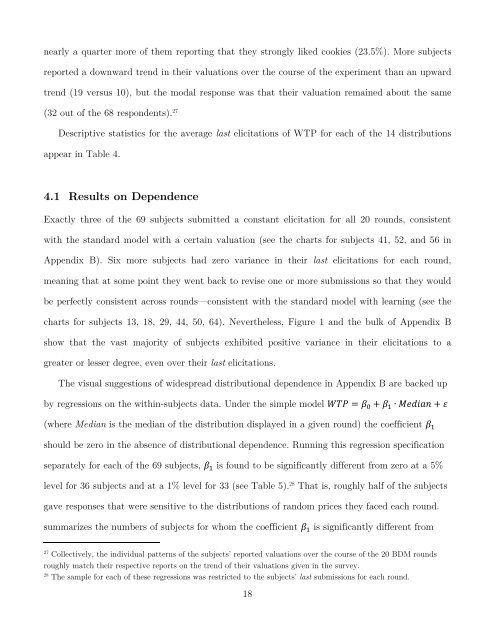Testing Distributional Dependence in the Becker-DeGroot-Marschak ...
Testing Distributional Dependence in the Becker-DeGroot-Marschak ...
Testing Distributional Dependence in the Becker-DeGroot-Marschak ...
Create successful ePaper yourself
Turn your PDF publications into a flip-book with our unique Google optimized e-Paper software.
nearly a quarter more of <strong>the</strong>m report<strong>in</strong>g that <strong>the</strong>y strongly liked cookies (23.5%). More subjects<br />
reported a downward trend <strong>in</strong> <strong>the</strong>ir valuations over <strong>the</strong> course of <strong>the</strong> experiment than an upward<br />
trend (19 versus 10), but <strong>the</strong> modal response was that <strong>the</strong>ir valuation rema<strong>in</strong>ed about <strong>the</strong> same<br />
(32 out of <strong>the</strong> 68 respondents). 27<br />
Descriptive statistics for <strong>the</strong> average last elicitations of WTP for each of <strong>the</strong> 14 distributions<br />
appear <strong>in</strong> Table 4.<br />
4.1 Results on <strong>Dependence</strong><br />
Exactly three of <strong>the</strong> 69 subjects submitted a constant elicitation for all 20 rounds, consistent<br />
with <strong>the</strong> standard model with a certa<strong>in</strong> valuation (see <strong>the</strong> charts for subjects 41, 52, and 56 <strong>in</strong><br />
Appendix B). Six more subjects had zero variance <strong>in</strong> <strong>the</strong>ir last elicitations for each round,<br />
mean<strong>in</strong>g that at some po<strong>in</strong>t <strong>the</strong>y went back to revise one or more submissions so that <strong>the</strong>y would<br />
be perfectly consistent across rounds—consistent with <strong>the</strong> standard model with learn<strong>in</strong>g (see <strong>the</strong><br />
charts for subjects 13, 18, 29, 44, 50, 64). Never<strong>the</strong>less, Figure 1 and <strong>the</strong> bulk of Appendix B<br />
show that <strong>the</strong> vast majority of subjects exhibited positive variance <strong>in</strong> <strong>the</strong>ir elicitations to a<br />
greater or lesser degree, even over <strong>the</strong>ir last elicitations.<br />
The visual suggestions of widespread distributional dependence <strong>in</strong> Appendix B are backed up<br />
by regressions on <strong>the</strong> with<strong>in</strong>-subjects data. Under <strong>the</strong> simple model ��� = � � + � � ∙ ������ + �<br />
(where Median is <strong>the</strong> median of <strong>the</strong> distribution displayed <strong>in</strong> a given round) <strong>the</strong> coefficient � �<br />
should be zero <strong>in</strong> <strong>the</strong> absence of distributional dependence. Runn<strong>in</strong>g this regression specification<br />
separately for each of <strong>the</strong> 69 subjects, � � is found to be significantly different from zero at a 5%<br />
level for 36 subjects and at a 1% level for 33 (see Table 5). 28 That is, roughly half of <strong>the</strong> subjects<br />
gave responses that were sensitive to <strong>the</strong> distributions of random prices <strong>the</strong>y faced each round.<br />
summarizes <strong>the</strong> numbers of subjects for whom <strong>the</strong> coefficient � � is significantly different from<br />
27 Collectively, <strong>the</strong> <strong>in</strong>dividual patterns of <strong>the</strong> subjects’ reported valuations over <strong>the</strong> course of <strong>the</strong> 20 BDM rounds<br />
roughly match <strong>the</strong>ir respective reports on <strong>the</strong> trend of <strong>the</strong>ir valuations given <strong>in</strong> <strong>the</strong> survey.<br />
28 The sample for each of <strong>the</strong>se regressions was restricted to <strong>the</strong> subjects’ last submissions for each round.<br />
18


